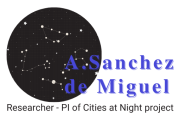I+D+i Projects
A Commitment to Excellence
Leader and founder of Cities at Night, a citizen support project coordinated with NASA, ESA and other space agencies that uses ISS night images to raising awareness about light pollution, I got my doctorate at the Complutense University of Madrid (UCM) with the thesis entitled «Spatial, temporal and spectral variation of light pollution and its sources: Methodology and results». My thesis was selected by the International Astronomical Union for a press release during the XXIX General Assembly in Honolulu, Hawaii.
I started my doctorate with an FPU scholarship to study star-forming galaxies at redshift 2, but delays in the production of EMIR -GranTCaN instruments and the meteorological problems in the subsequent observations forced me to change the subject of doctorate.
I did a predoctoral stay at the Institute of Space Sciences of the Freie Universität in Berlin and a postdoctoral stay at the CEGEP in Sherbrooke (Quebec, Canada).
Real Artificial Light at Night Map R-ALAN
UNA4CAREER UNA Europa, an alliance of universities FOR the emergence of talent and the development of research CAREERs - Grant number: 847635
Proposal Summary
The images of the earth at night are one of the most recognizable images of our time as an example of the environmental impact that human beings produce on the earth. However, these images have limited scientific use because they were acquired with a SNPP VIIRS / DNB panchromatic sensor (black and white) and later coloured for artistic purposes. On the other hand, the images taken by the astronauts of the international space station are actually in colour and of higher quality but due to the peculiarities of having been acquired by human beings and commercial reflex cameras, they have not had the same scientific impact as the previous ones. In this proposal we intend to complete the task initiated by the Cities at Night and EMISSI@N projects that have demonstrated the scientific potential of these images, creating an Atlas of European light pollution using citizen science and artificial intelligence.
This will allow you to use these images for multiple uses, such as cancer epidemiology, citizen security, energy efficiency, protection of biodiversity, government advice and many more applications. In parallel and as a complement to the atlas, three activities will be carried out: 1-It will work with some of the companies in the aerospace sector to establish a spectral sensitivity standard in order to guarantee the interoperability of future public and private missions. 2-A high- resolution map of the city of Berlin will be made to explore the limitations and strengths of satellite images. 3-A mutual advisory work will be carried out between the Ministry of the Environment of the Czech Republic and the researcher, on light pollution, from the administrative / political and technical / academic perspective, respectively. These three activities will guarantee that the researcher can have a professional future outside the academic sphere if necessary.

This project has received funding from the European Union’s Horizon 2020 research and innovation programme under the Marie Skłodowska-Curie grant agreement No 847635
EMISS@IN Natural Environment Research Council.
NE/P01156X/1, Kevin J. Gaston.
(University of Exeter). 01/08/2017-31/07/2020. PI
Lost at Night v2, for Cities at Night Project
FCT-18-14201, 2019. PI
Red española de estudios sobre la contaminación lumínica
AYA2015-71542-REDT, Jesus Gallego
Maestro. (Universidad Complutense de Madrid). 01/12/2015- 30/11/2017.
